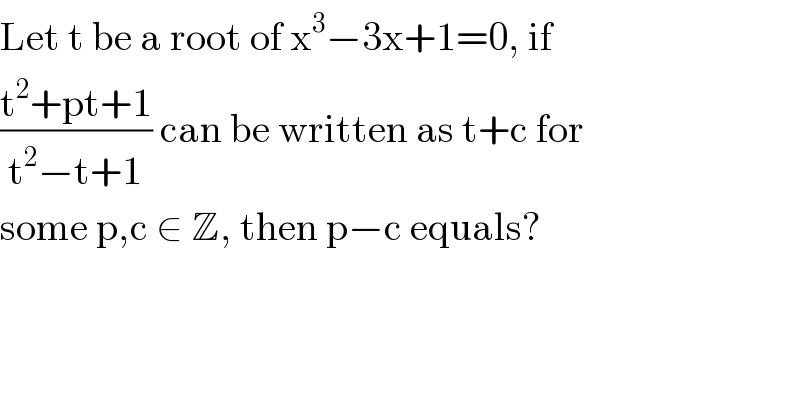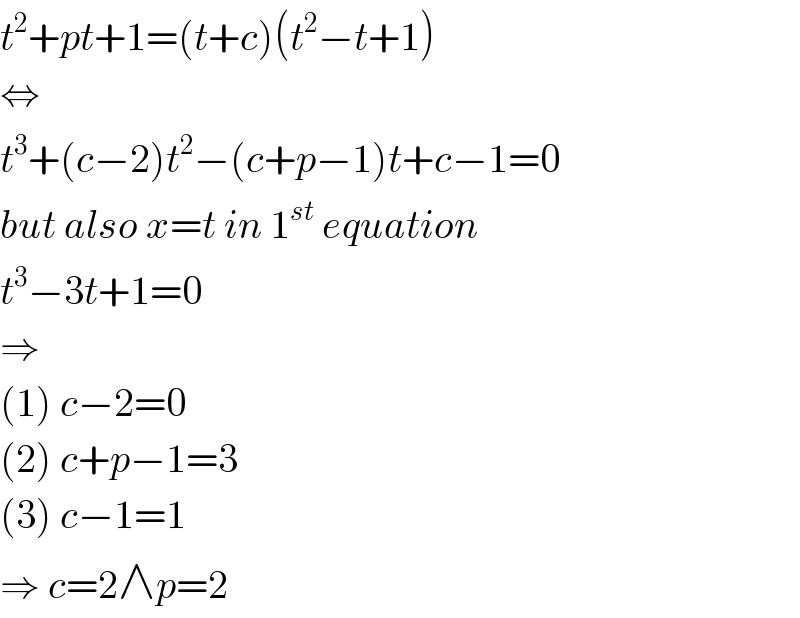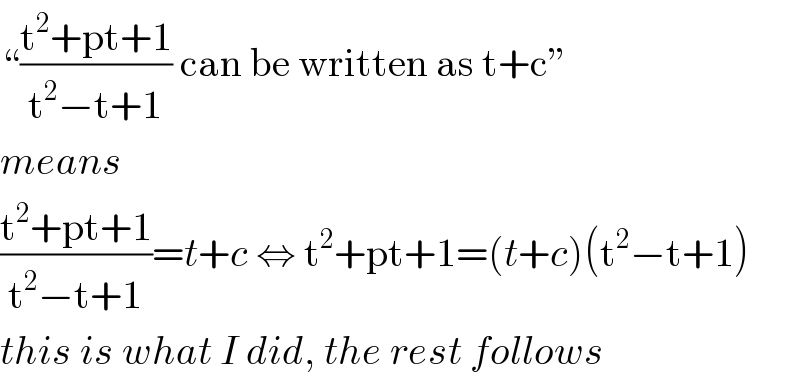
Question Number 110419 by Aina Samuel Temidayo last updated on 28/Aug/20

$$\mathrm{Let}\:\mathrm{t}\:\mathrm{be}\:\mathrm{a}\:\mathrm{root}\:\mathrm{of}\:\mathrm{x}^{\mathrm{3}} −\mathrm{3x}+\mathrm{1}=\mathrm{0},\:\mathrm{if}\: \\ $$$$\frac{\mathrm{t}^{\mathrm{2}} +\mathrm{pt}+\mathrm{1}}{\mathrm{t}^{\mathrm{2}} −\mathrm{t}+\mathrm{1}}\:\mathrm{can}\:\mathrm{be}\:\mathrm{written}\:\mathrm{as}\:\mathrm{t}+\mathrm{c}\:\mathrm{for} \\ $$$$\mathrm{some}\:\mathrm{p},\mathrm{c}\:\in\:\mathbb{Z},\:\mathrm{then}\:\mathrm{p}−\mathrm{c}\:\mathrm{equals}? \\ $$
Commented by Her_Majesty last updated on 28/Aug/20

$${p},\:{z}\:\in\mathbb{Z}\:{or}\:{p},\:{c}\:\in\mathbb{Z}? \\ $$
Commented by Aina Samuel Temidayo last updated on 28/Aug/20

$$\mathrm{Oh}.\:\mathrm{Sorry}\:\mathrm{for}\:\mathrm{that}.\:\mathrm{It}\:\mathrm{has}\:\mathrm{been} \\ $$$$\mathrm{corrected}. \\ $$
Answered by Her_Majesty last updated on 28/Aug/20

$${t}^{\mathrm{2}} +{pt}+\mathrm{1}=\left({t}+{c}\right)\left({t}^{\mathrm{2}} −{t}+\mathrm{1}\right) \\ $$$$\Leftrightarrow \\ $$$${t}^{\mathrm{3}} +\left({c}−\mathrm{2}\right){t}^{\mathrm{2}} −\left({c}+{p}−\mathrm{1}\right){t}+{c}−\mathrm{1}=\mathrm{0} \\ $$$${but}\:{also}\:{x}={t}\:{in}\:\mathrm{1}^{{st}} \:{equation} \\ $$$${t}^{\mathrm{3}} −\mathrm{3}{t}+\mathrm{1}=\mathrm{0} \\ $$$$\Rightarrow \\ $$$$\left(\mathrm{1}\right)\:{c}−\mathrm{2}=\mathrm{0} \\ $$$$\left(\mathrm{2}\right)\:{c}+{p}−\mathrm{1}=\mathrm{3} \\ $$$$\left(\mathrm{3}\right)\:{c}−\mathrm{1}=\mathrm{1} \\ $$$$\Rightarrow\:{c}=\mathrm{2}\wedge{p}=\mathrm{2} \\ $$
Commented by Aina Samuel Temidayo last updated on 28/Aug/20

$$\mathrm{Implies}\:\mathrm{p}−\mathrm{c}=\mathrm{0}\:\mathrm{right}? \\ $$
Commented by Aina Samuel Temidayo last updated on 28/Aug/20

$$\mathrm{Why}\:\mathrm{are}\:\mathrm{we}\:\mathrm{dealing}\:\mathrm{with}\:\mathrm{the} \\ $$$$\mathrm{numerator}\:\mathrm{only}?\:\mathrm{Could}\:\mathrm{you}\:\mathrm{please} \\ $$$$\mathrm{shed}\:\mathrm{more}\:\mathrm{light}\:\mathrm{on}\:\mathrm{it}?\:\mathrm{And}\:\mathrm{why}\:\mathrm{did} \\ $$$$\mathrm{you}\:\mathrm{equate}\:\mathrm{the}\:\mathrm{numerator}\:\mathrm{to}\:\mathrm{0}? \\ $$
Commented by Her_Majesty last updated on 28/Aug/20

$$``\frac{\mathrm{t}^{\mathrm{2}} +\mathrm{pt}+\mathrm{1}}{\mathrm{t}^{\mathrm{2}} −\mathrm{t}+\mathrm{1}}\:\mathrm{can}\:\mathrm{be}\:\mathrm{written}\:\mathrm{as}\:\mathrm{t}+\mathrm{c}'' \\ $$$${means} \\ $$$$\frac{\mathrm{t}^{\mathrm{2}} +\mathrm{pt}+\mathrm{1}}{\mathrm{t}^{\mathrm{2}} −\mathrm{t}+\mathrm{1}}={t}+{c}\:\Leftrightarrow\:\mathrm{t}^{\mathrm{2}} +\mathrm{pt}+\mathrm{1}=\left({t}+{c}\right)\left(\mathrm{t}^{\mathrm{2}} −\mathrm{t}+\mathrm{1}\right) \\ $$$${this}\:{is}\:{what}\:{I}\:{did},\:{the}\:{rest}\:{follows} \\ $$
Commented by Aina Samuel Temidayo last updated on 28/Aug/20

$$\mathrm{Thanks},\:\mathrm{I}\:\mathrm{really}\:\mathrm{appreciate}\:\mathrm{that}.\:\mathrm{You} \\ $$$$\mathrm{can}\:\mathrm{also}\:\mathrm{look}\:\mathrm{up}\:\mathrm{other}\:\mathrm{questions}\:\mathrm{I} \\ $$$$\mathrm{posted}. \\ $$
